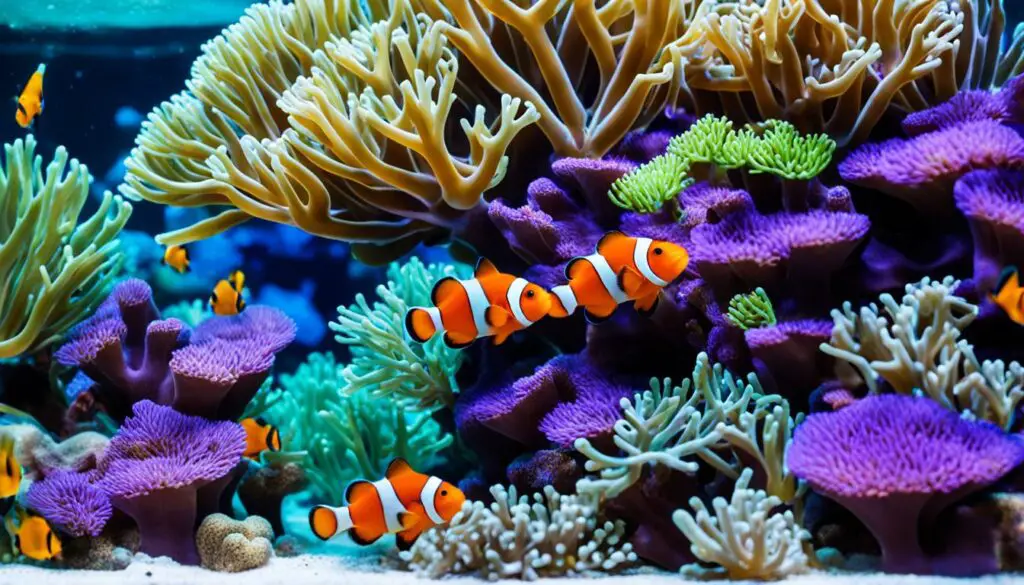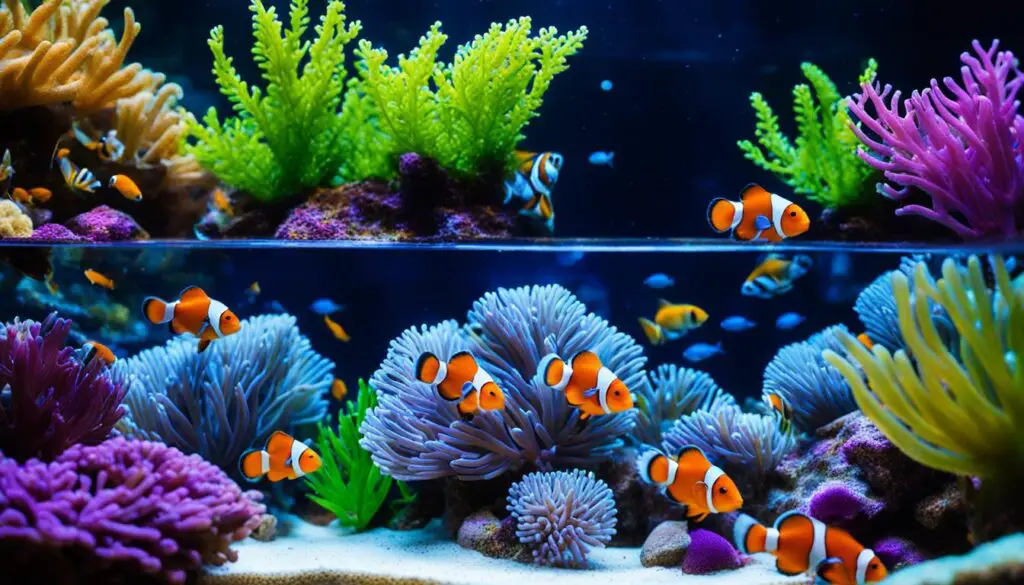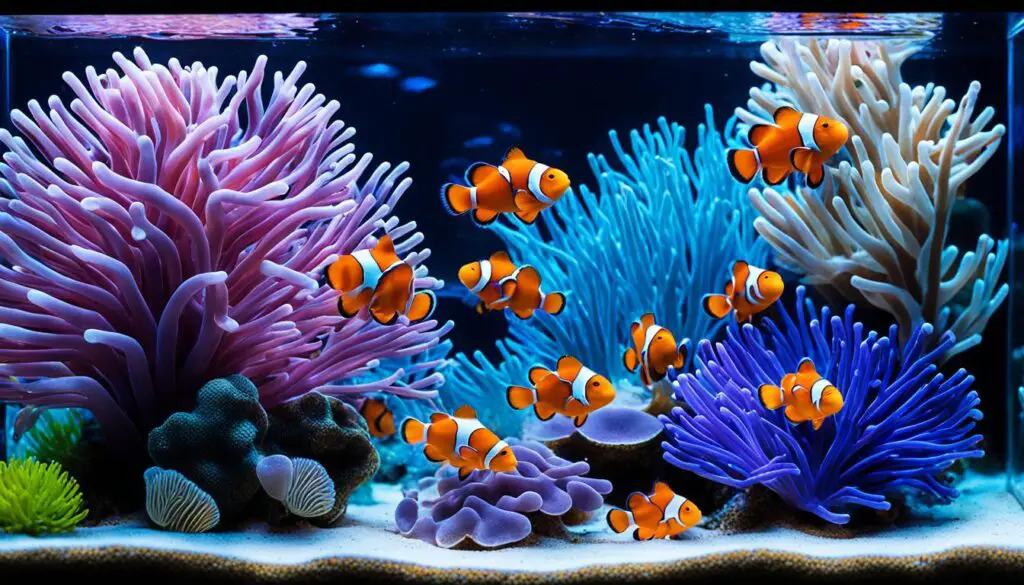Clownfish Behavior Demystified: Insider Insights
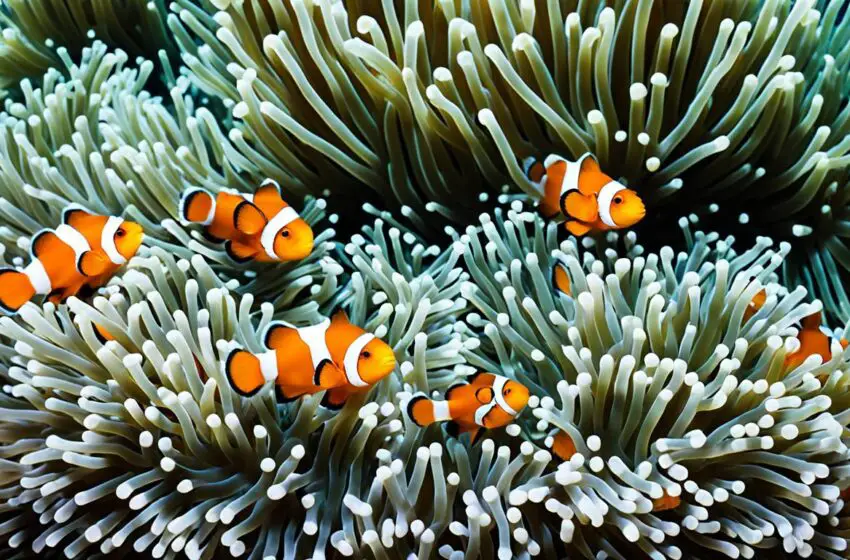
Clownfish, known for their vibrant colors, have fascinating behavior. To care for them right, understanding their ways is key. By listening to experts, we learn how to keep these fish happy.
Key Takeaways:
- Understanding clownfish behavior is crucial for proper care in an aquatic setting.
- Experts teach us about the behavior patterns of clownfish.
- Creating a living space where clownfish can thrive involves knowing their specific needs.
- Good care ensures the health and well-being of clownfish in a fish tank.
- Once we know how they behave, we can give them a home that supports their natural ways.
The Sound-Producing Mechanism of Clownfishes
A study was done to explore how clownfish make sounds. It was done by Orphal Colleye, Masaru Nakamura, Bruno Frédérich, and Eric Parmentier. They looked into how these fish create and use sounds to communicate. Their findings shed light on the intricate world of clownfish communication.
“Clownfishes have long been known for their unique behaviors, including their sound production capabilities,” said Dr. Orphal Colleye, the lead researcher. “We wanted to understand the specific structures involved in the production and radiation of these sounds.”
They concentrated on Amphiprion akallopisos, a type of clownfish. The research team made careful observations and studied its body parts. They found out that the swim bladder helps these fishes in making sounds.
The swim bladder is a specialized organ filled with gas. It helps the clownfish stay afloat. But in these fishes, it also serves as a key part for creating sounds.
Clownfish make sounds by moving muscles that are connected to their swim bladder. This makes the swim bladder vibrate, producing sound waves. These waves carry messages through the water. Clownfish use this to talk to each other and maybe to warn about danger.
Their study showed that different clownfish types use different ways to make sounds. Some have special body parts that help them make louder or clearer sounds. This gives them an edge in their underwater world.
Understanding how clownfish make sounds is important. It helps us see how they talk and get along with others. It also shows us how complex their language and social life underwater are.
This research adds to what we know about clownfish. It shows how their sounds work and why they make them. This knowledge is part of the big picture of understanding clownfish and their behavior.
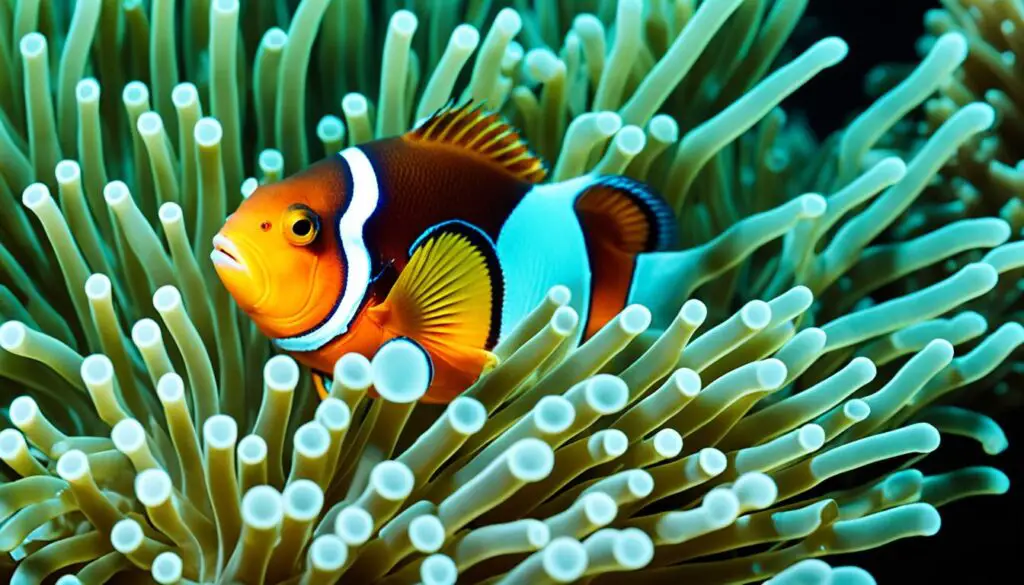
The Sound-Producing Mechanism of Clownfishes – Summary of Findings
| Key Findings | Implications |
|---|---|
| The swim bladder is the primary structure involved in sound production. | Understanding how clownfishes produce sound enhances our knowledge of their communication methods. |
| The sound-producing mechanism varies among different clownfish species. | Species-specific adaptations contribute to the diversity of sound production abilities among clownfishes. |
| Sound signals play a vital role in clownfish social interactions. | Sound communication serves as a tool for warning, cooperation, and establishing territory among clownfishes. |
The Genomic Architecture of Clownfish Diversification
A recent study aimed to uncover how the clownfish evolved through their genes. They looked at the genes of five pairs of clownfish. These pairs were very similar but lived in different places.
They found that certain genes had bursts of activity. These genes help control how other genes work. This can lead to quick changes in a clownfish type, making them different from each other.
The findings showed that genes related to social behavior and ecology change fast. This is because they help the fish fit into their homes better.
The study also found that some genes carried down by older species were still found in the newer ones. This mix-up adds layers to how clownfish evolved. It shows that their story is not simple but full of twists and turns.
They also found evidence that clownfish sometimes mixed their genes by breeding with different species. This mixing introduced new gene combinations. These new genes could help the fish as they adapted to their changing environment.
Genes Associated with Social Behavior and Ecology
The study’s discovery of specific genes helps explain why clownfish live together in a certain way. If you’ve seen “Finding Nemo,” you know how they stick together. These genes might be the reason behind their unique social structure.
The study deepens our knowledge of how clownfish evolved. It shows how their genes and unique processes led to their diverse species. This research is crucial for understanding how marine life evolves.
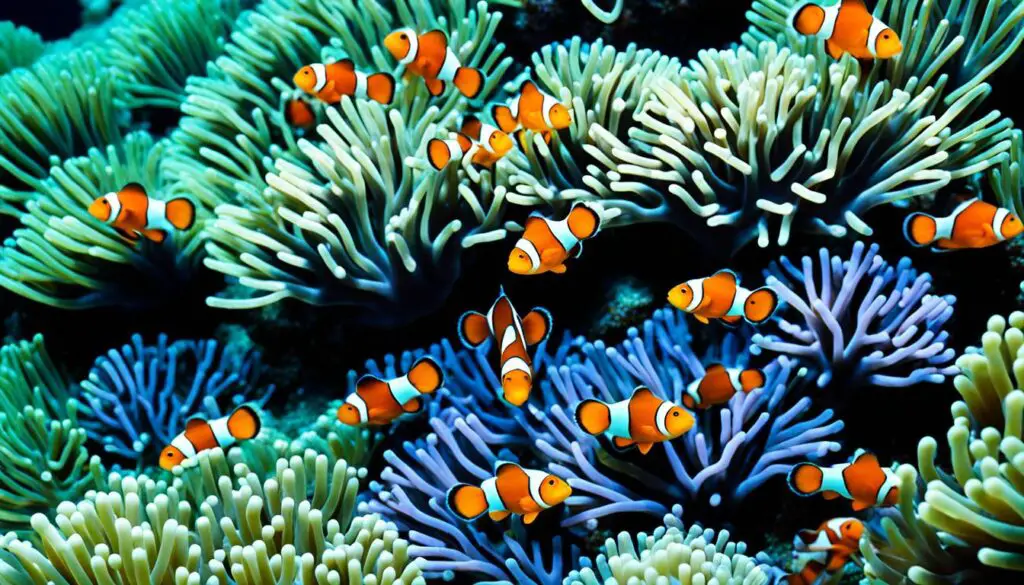
| Genomic Factors | Key Insights |
|---|---|
| Bursts of Transposable Elements | Facilitate rapid genetic changes contributing to species divergence |
| Accelerated Coding Evolution | Genes associated with social behavior and ecology are subject to positive selection, driving adaptations |
| Incomplete Lineage Sorting | Certain genetic variations from ancestral species are retained in descendant species |
| Ancestral Hybridization Events | Interbreeding between clownfish species introduces novel genetic variations |
This research is big for understanding how clownfish became so diverse. The findings about their genes and how they evolved are key. They help piece together the puzzle of marine life evolution.
The Molecular Basis of Decision Making in Stickleback Fish
Tina Barbasch and Alison Bell led a key study. They looked at how three-spined stickleback fish make decisions. The aim was to see why these fish do certain things when they have different needs at the same time. This work helps us see how animals decide, giving us new insights.
Barbasch and Bell put male sticklebacks to various tests. They checked how the fish acted and what genes were active. They found that these males choose to protect their territory first, even over finding a mate. This choice is tied to how their brains react when they need to pick between different things.
The study uncovers the genes and molecules in the fish that guide their choices. By looking at the genes connected to decisions, experts get a better look at the biology. This understanding could help in many areas, like the study of the brain and animal actions. In the end, it broadens our insight into how choices are made, not just in fish but in all kinds of creatures, including people.
FAQ
What is the behavior of clownfish?
Clownfish show interesting behavior that is complex. They form a structured social group based on size. There’s a dominant female and male. They communicate through sounds and visuals, which is fascinating.
How can I create a thriving aquatic environment for clownfish?
To keep clownfish happy, a proper tank and water conditions are crucial. Adding anemones is also important for their health and safety. You must feed them well and keep an eye on their environment.
Can clownfish produce sounds?
Clownfish do make sounds. Research shows they have a special way to make noise. This sound helps them communicate and interact with other fish.
What is the genomic architecture of clownfish diversification?
Scientists have found many genetic factors that explain clownfish diversification. These include the activity of transposable elements and unique genes. They have discovered genes linked to their social behaviors and size-based social structure.
How do stickleback fish make decisions?
Stickleback fish decide by weighing different cues and using their genes. Males mostly choose to protect their territory over mating. They have specific brain reactions, showing their intricate decision-making abilities.
This helps us understand more about animal decision making.
What are the molecular mechanisms underlying decision making in stickleback fish?
The decision-making in stickleback fish is linked to certain genes. By looking at how genes are expressed in their brains, researchers found out about their decision processes. This includes how they balance protecting territory with mating efforts.

